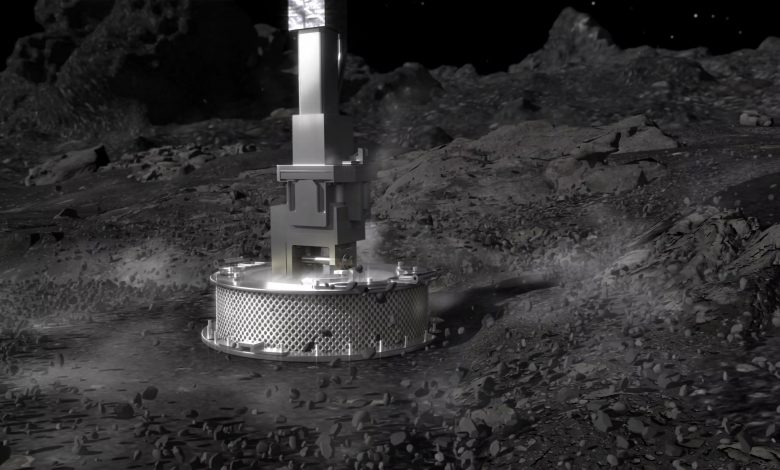
NASA succeeds in landing on asteroid Bennu
ناسا تنجح في الهبوط على كويكب بينو
TRTWorld and agencies
A NASA spacecraft has touched down on the rugged surface of the Bennu asteroid, grabbing a sample of rocks dating back to the birth of our solar system to bring home.
The minivan-sized OSIRIS-REx spacecraft, built by Lockheed Martin, extended its 3.35 metres (11-foot) robotic arm toward a flat patch of gravel near Bennu’s north pole and plucked the sample of rocks, the space agency’s first handful of pristine asteroid rocks.
“Sample collection is complete, and the back-away burn has executed,” Lockheed mission operator Estelle Church added seconds later, confirming the spacecraft eased away from the space rock after making contact.
The probe will send back images of the sample collection on Wednesday and throughout the week so scientists can examine how much material was retrieved and determine whether the probe will need to make another collection attempt.
If a successful collection is confirmed, the spacecraft will journey back toward Earth, arriving in 2023. Japan is the only other country to have already accomplished this.
Bennu, located over 100 million miles from Earth and whose acorn-shaped body formed in the early days of our solar system, could hold clues to the origins of life on Earth, scientists say. “Everything went just exactly perfect,” Dante Lauretta, OSIRIS-REx principal investigator from the University of Arizona, Tucson, said on a NASA live feed from Lockheed’s mission support building. “We have overcome the amazing challenges that this asteroid has thrown at us, and the spacecraft appears to have operated flawlessly.”
The robotic arm’s colle ction device, shaped like an oversized shower head, is designed to release a pressurised gas to kick up debris.
The spacecraft launched in 2016 from Kennedy Space Center for the journey to Bennu. It has been in orbit around the asteroid for nearly two years preparing for the “touch and go” maneuver.
“A lot of things could go wrong because the spacecraft’s about the size of a van, and the asteroid has a lot of boulders in it,” Lucy Lim, a planetary scientist at NASA, said in an earlier interview. “So we have to go between the boulders to get our sample, and a lot of plann ing went into that.”
Asteroids are among the leftover debris from the solar system’s formation some 4.5 billion years ago. Scientists believe asteroids and comets crashing into early Earth may have delivered organic compounds and water that seeded the planet for life.
Atomic-level analysis of samples from Bennu could provide key evidence to support that hypothesis.
قنا
واشنطن: أعلنت إدارة الطيران والفضاء الأمريكية /ناسا/ أن مركبتها الفضائية /أوسايرس-ركس/ هبطت بنجاح على الكويكب /بينو/ وجمعت عينة من سطحه، في أول مهمة أمريكية لاستعادة عينة من كويكب وإعادتها إلى الأرض لإجراء مزيد من الدراسات.
ومدت مركبة الفضاء ذراعها الآلية التي يبلغ طولها 3.35 متر نحو بقعة مسطحة من الحصى قرب القطب الشمالي لـ/بينو/، والتقطت عينة الصخور، وهي أول حفنة من صخور الكويكبات البكر لناسا.
وقالت إستيل تشيرش، المسؤولة عن تنفيذ المهمة “اكتمل جمع العينة” …مؤكدة أن المركبة ابتعدت عن الكويكب بعد إتمام المهمة.
ونفذت المركبة التسلسل الكامل للاقتراب من الكويكب وجمع العينة بشكل مستقل في مدة استمرت حوالي 4.5 ساعة.
وسترسل المركبة صورا لمجموعة العينات اليوم، حتى يتمكن العلماء من فحص كمية المواد التي تم جمعها، وتحديدا ما إذا كانت المركبة ستحتاج إلى القيام بمحاولة أخرى لجمع العينات.
وإذا ثبت نجاح جمع العينة، فستعود المركبة إلى الأرض لتصل في عام 2023.
يذكر أن /أوسايرس-ركس/ أطلقته ناسا في سبتمبر عام 2016 في إطار البرنامج الذي يهدف إلى جمع عينات من تربة كويكب /بينو/ ونقلها إلى الأرض، ووصل إلى منطقة الكويكب في ديسمبر عام 2018.
ويبعد الكويكب الذي يعرف بأنه داكن اللون، نحو 334 مليون كيلومتر عن الأرض، وتم اكتشافه في ديسمبر من عام 1999.



